Change Management Report: SSU's Change Process Analysis
VerifiedAdded on 2021/06/17
|15
|3987
|351
Report
AI Summary
This report provides a detailed analysis of the change management plan initiated by the Vice-Chancellor at Super Star University (SSU) in Australia. The report examines the external environment impacting the university, including shifting student demographics and government pressures. It delves into the change processes implemented, including assessment, communication strategies, and the role of leadership in driving change. The report also explores the development and delivery of training programs designed to facilitate the transition. A key focus is the resistance to change encountered within SSU, and the reasons for the failure of the initial change process, including employee resistance and poor management. The report compares the approaches taken by different departments within SSU, highlighting the importance of inclusivity, communication, and employee engagement. Finally, the report offers recommendations for improving future change management initiatives to ensure successful transformation within the university. The report concludes with references to relevant academic literature.
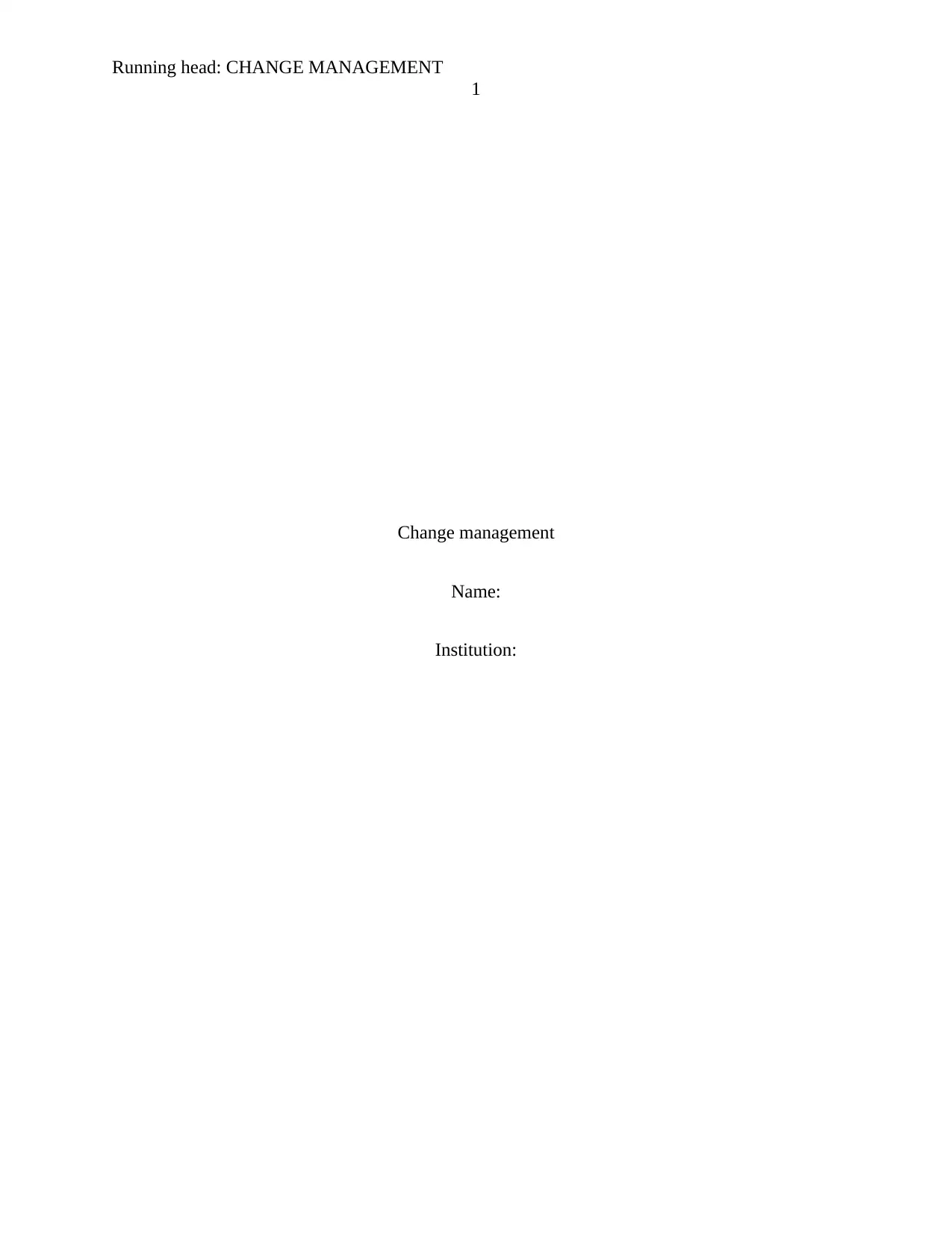
Running head: CHANGE MANAGEMENT
1
Change management
Name:
Institution:
1
Change management
Name:
Institution:
Paraphrase This Document
Need a fresh take? Get an instant paraphrase of this document with our AI Paraphraser
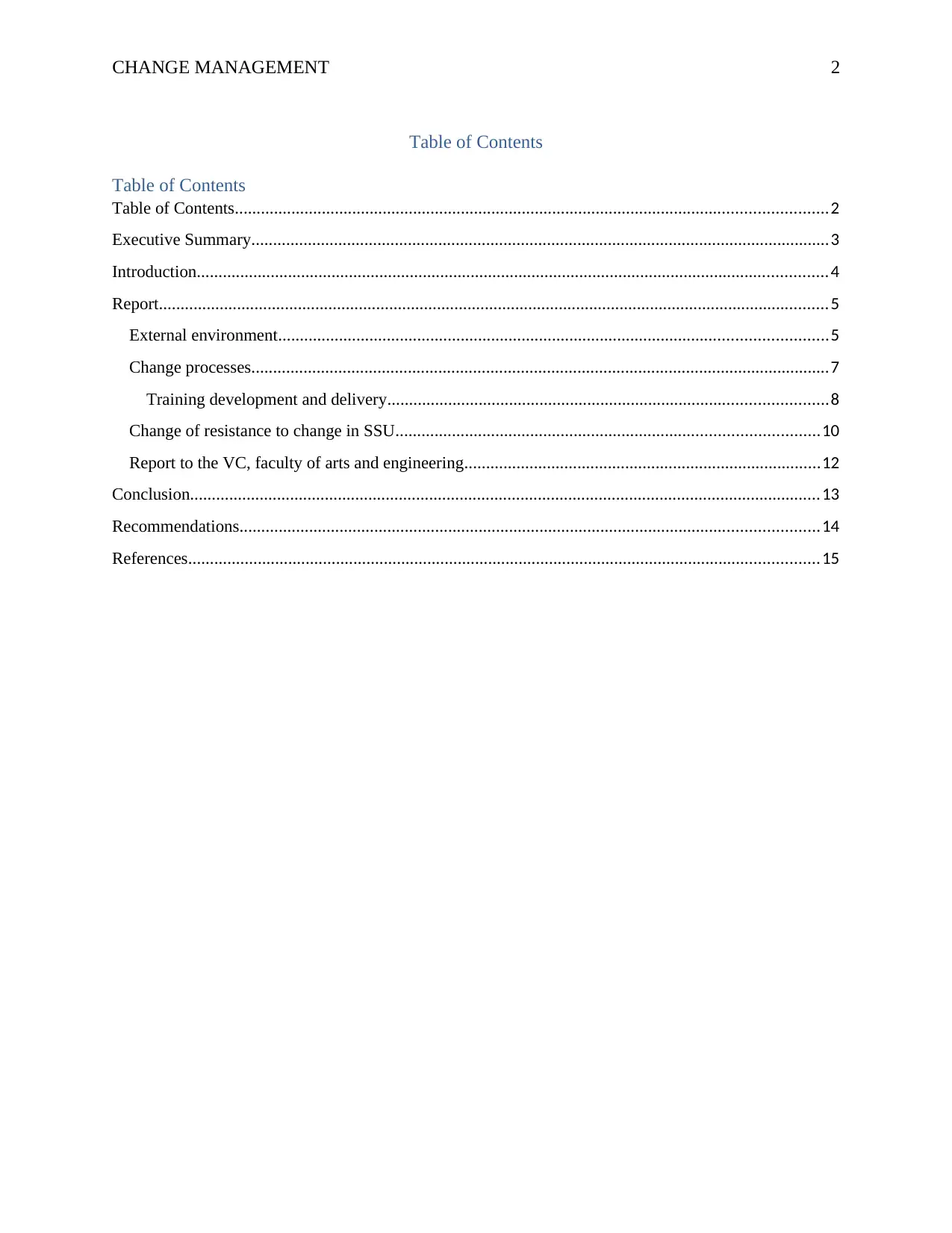
CHANGE MANAGEMENT 2
Table of Contents
Table of Contents
Table of Contents........................................................................................................................................2
Executive Summary.....................................................................................................................................3
Introduction.................................................................................................................................................4
Report..........................................................................................................................................................5
External environment..............................................................................................................................5
Change processes.....................................................................................................................................7
Training development and delivery.....................................................................................................8
Change of resistance to change in SSU.................................................................................................10
Report to the VC, faculty of arts and engineering..................................................................................12
Conclusion.................................................................................................................................................13
Recommendations.....................................................................................................................................14
References.................................................................................................................................................15
Table of Contents
Table of Contents
Table of Contents........................................................................................................................................2
Executive Summary.....................................................................................................................................3
Introduction.................................................................................................................................................4
Report..........................................................................................................................................................5
External environment..............................................................................................................................5
Change processes.....................................................................................................................................7
Training development and delivery.....................................................................................................8
Change of resistance to change in SSU.................................................................................................10
Report to the VC, faculty of arts and engineering..................................................................................12
Conclusion.................................................................................................................................................13
Recommendations.....................................................................................................................................14
References.................................................................................................................................................15
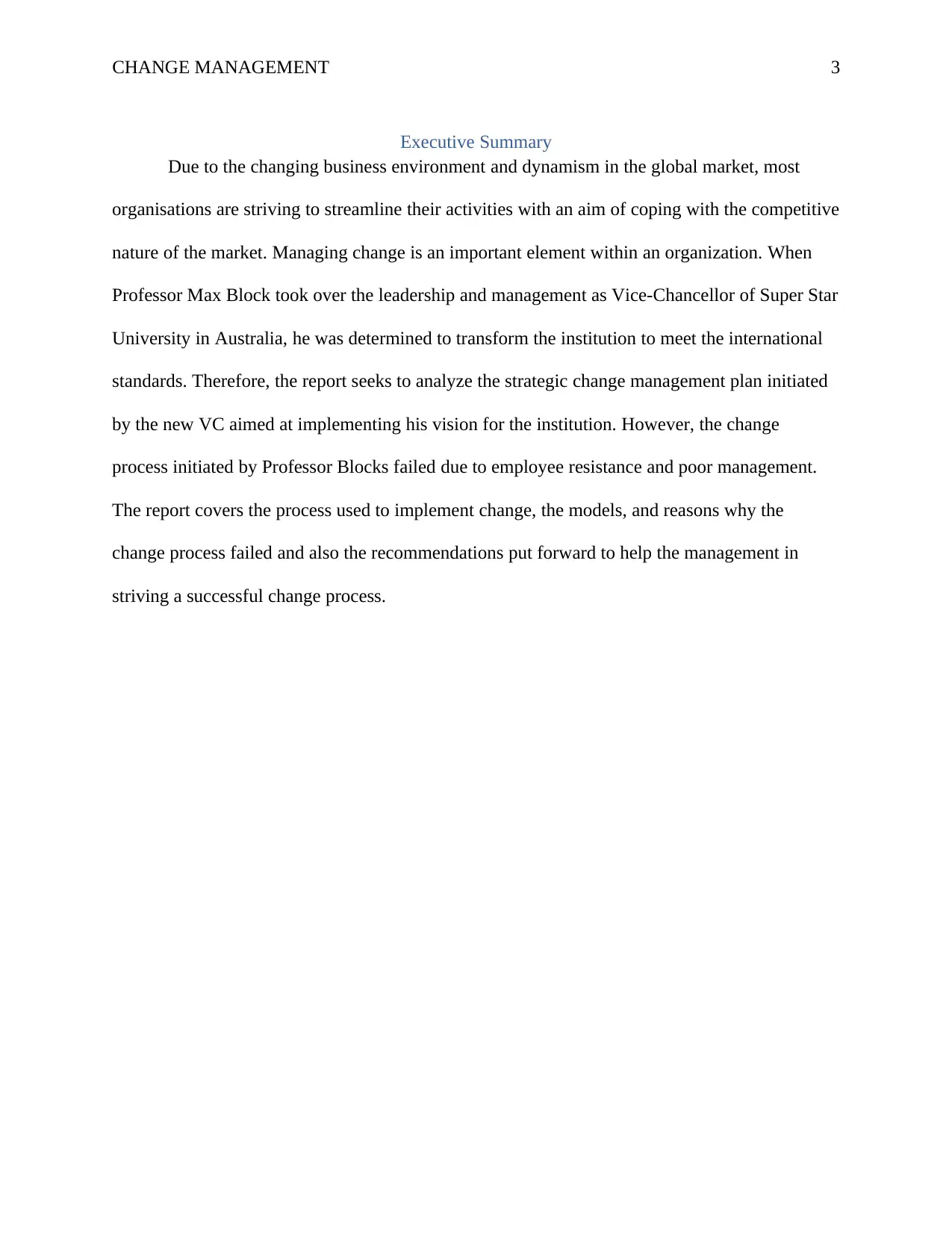
CHANGE MANAGEMENT 3
Executive Summary
Due to the changing business environment and dynamism in the global market, most
organisations are striving to streamline their activities with an aim of coping with the competitive
nature of the market. Managing change is an important element within an organization. When
Professor Max Block took over the leadership and management as Vice-Chancellor of Super Star
University in Australia, he was determined to transform the institution to meet the international
standards. Therefore, the report seeks to analyze the strategic change management plan initiated
by the new VC aimed at implementing his vision for the institution. However, the change
process initiated by Professor Blocks failed due to employee resistance and poor management.
The report covers the process used to implement change, the models, and reasons why the
change process failed and also the recommendations put forward to help the management in
striving a successful change process.
Executive Summary
Due to the changing business environment and dynamism in the global market, most
organisations are striving to streamline their activities with an aim of coping with the competitive
nature of the market. Managing change is an important element within an organization. When
Professor Max Block took over the leadership and management as Vice-Chancellor of Super Star
University in Australia, he was determined to transform the institution to meet the international
standards. Therefore, the report seeks to analyze the strategic change management plan initiated
by the new VC aimed at implementing his vision for the institution. However, the change
process initiated by Professor Blocks failed due to employee resistance and poor management.
The report covers the process used to implement change, the models, and reasons why the
change process failed and also the recommendations put forward to help the management in
striving a successful change process.
⊘ This is a preview!⊘
Do you want full access?
Subscribe today to unlock all pages.

Trusted by 1+ million students worldwide
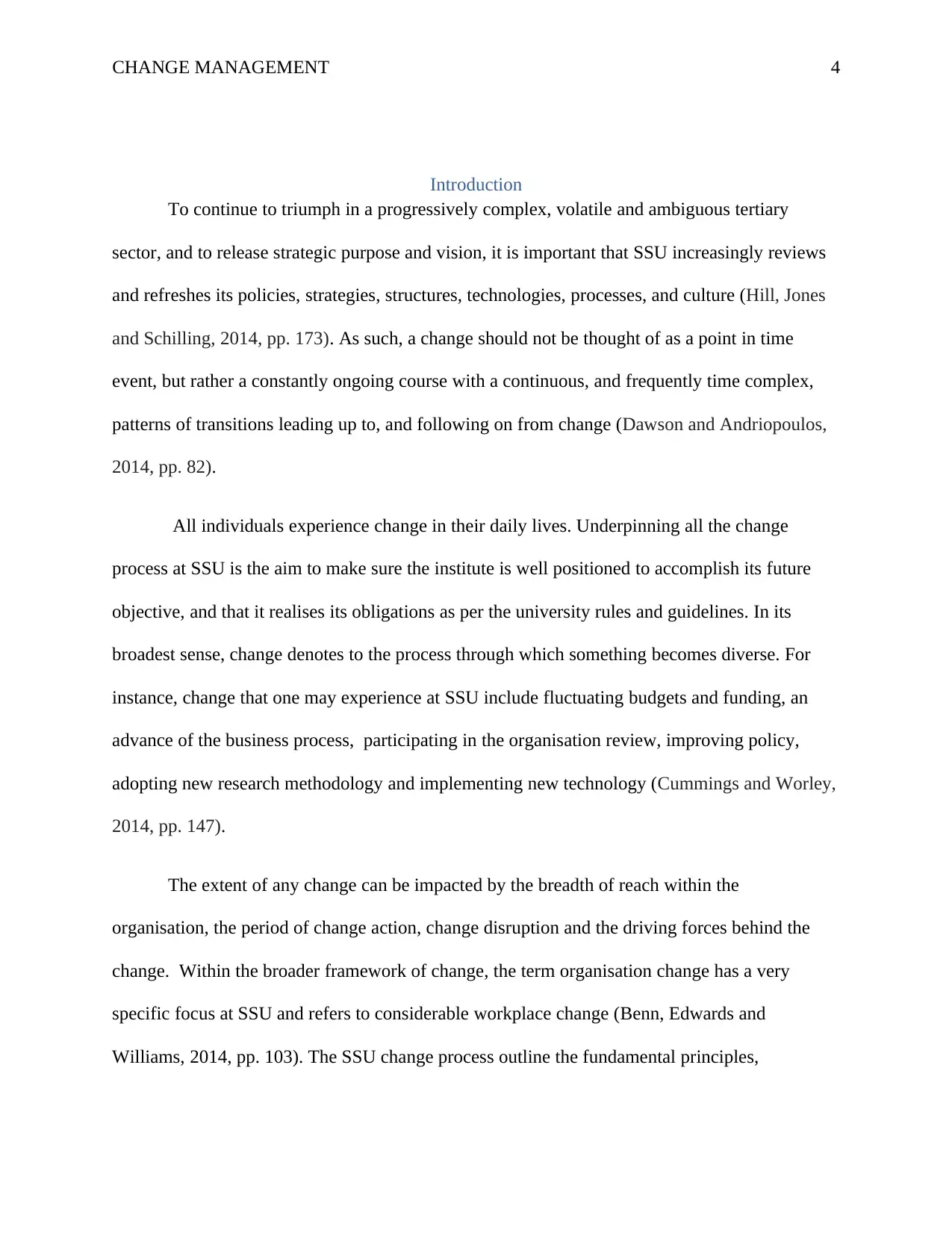
CHANGE MANAGEMENT 4
Introduction
To continue to triumph in a progressively complex, volatile and ambiguous tertiary
sector, and to release strategic purpose and vision, it is important that SSU increasingly reviews
and refreshes its policies, strategies, structures, technologies, processes, and culture (Hill, Jones
and Schilling, 2014, pp. 173). As such, a change should not be thought of as a point in time
event, but rather a constantly ongoing course with a continuous, and frequently time complex,
patterns of transitions leading up to, and following on from change (Dawson and Andriopoulos,
2014, pp. 82).
All individuals experience change in their daily lives. Underpinning all the change
process at SSU is the aim to make sure the institute is well positioned to accomplish its future
objective, and that it realises its obligations as per the university rules and guidelines. In its
broadest sense, change denotes to the process through which something becomes diverse. For
instance, change that one may experience at SSU include fluctuating budgets and funding, an
advance of the business process, participating in the organisation review, improving policy,
adopting new research methodology and implementing new technology (Cummings and Worley,
2014, pp. 147).
The extent of any change can be impacted by the breadth of reach within the
organisation, the period of change action, change disruption and the driving forces behind the
change. Within the broader framework of change, the term organisation change has a very
specific focus at SSU and refers to considerable workplace change (Benn, Edwards and
Williams, 2014, pp. 103). The SSU change process outline the fundamental principles,
Introduction
To continue to triumph in a progressively complex, volatile and ambiguous tertiary
sector, and to release strategic purpose and vision, it is important that SSU increasingly reviews
and refreshes its policies, strategies, structures, technologies, processes, and culture (Hill, Jones
and Schilling, 2014, pp. 173). As such, a change should not be thought of as a point in time
event, but rather a constantly ongoing course with a continuous, and frequently time complex,
patterns of transitions leading up to, and following on from change (Dawson and Andriopoulos,
2014, pp. 82).
All individuals experience change in their daily lives. Underpinning all the change
process at SSU is the aim to make sure the institute is well positioned to accomplish its future
objective, and that it realises its obligations as per the university rules and guidelines. In its
broadest sense, change denotes to the process through which something becomes diverse. For
instance, change that one may experience at SSU include fluctuating budgets and funding, an
advance of the business process, participating in the organisation review, improving policy,
adopting new research methodology and implementing new technology (Cummings and Worley,
2014, pp. 147).
The extent of any change can be impacted by the breadth of reach within the
organisation, the period of change action, change disruption and the driving forces behind the
change. Within the broader framework of change, the term organisation change has a very
specific focus at SSU and refers to considerable workplace change (Benn, Edwards and
Williams, 2014, pp. 103). The SSU change process outline the fundamental principles,
Paraphrase This Document
Need a fresh take? Get an instant paraphrase of this document with our AI Paraphraser
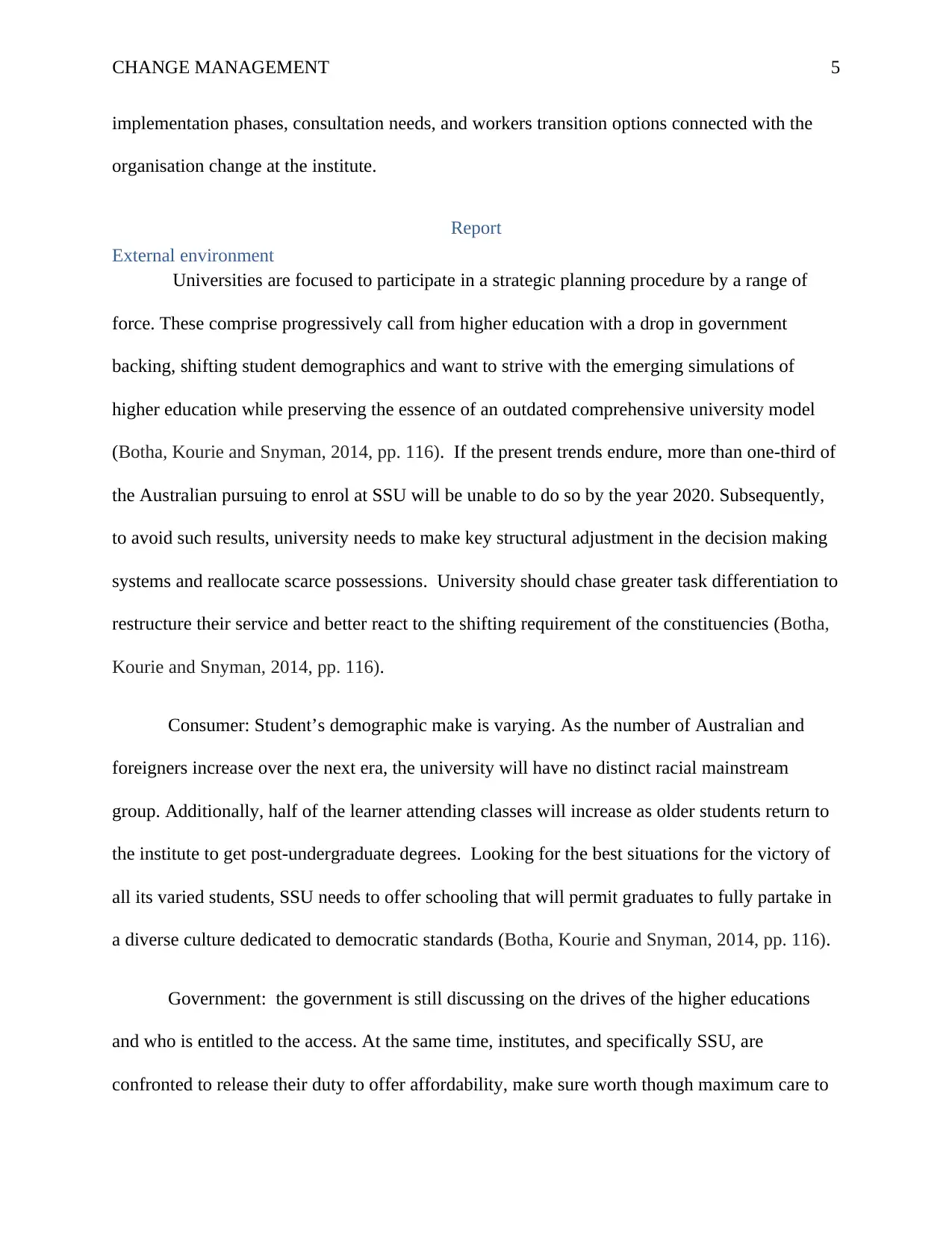
CHANGE MANAGEMENT 5
implementation phases, consultation needs, and workers transition options connected with the
organisation change at the institute.
Report
External environment
Universities are focused to participate in a strategic planning procedure by a range of
force. These comprise progressively call from higher education with a drop in government
backing, shifting student demographics and want to strive with the emerging simulations of
higher education while preserving the essence of an outdated comprehensive university model
(Botha, Kourie and Snyman, 2014, pp. 116). If the present trends endure, more than one-third of
the Australian pursuing to enrol at SSU will be unable to do so by the year 2020. Subsequently,
to avoid such results, university needs to make key structural adjustment in the decision making
systems and reallocate scarce possessions. University should chase greater task differentiation to
restructure their service and better react to the shifting requirement of the constituencies (Botha,
Kourie and Snyman, 2014, pp. 116).
Consumer: Student’s demographic make is varying. As the number of Australian and
foreigners increase over the next era, the university will have no distinct racial mainstream
group. Additionally, half of the learner attending classes will increase as older students return to
the institute to get post-undergraduate degrees. Looking for the best situations for the victory of
all its varied students, SSU needs to offer schooling that will permit graduates to fully partake in
a diverse culture dedicated to democratic standards (Botha, Kourie and Snyman, 2014, pp. 116).
Government: the government is still discussing on the drives of the higher educations
and who is entitled to the access. At the same time, institutes, and specifically SSU, are
confronted to release their duty to offer affordability, make sure worth though maximum care to
implementation phases, consultation needs, and workers transition options connected with the
organisation change at the institute.
Report
External environment
Universities are focused to participate in a strategic planning procedure by a range of
force. These comprise progressively call from higher education with a drop in government
backing, shifting student demographics and want to strive with the emerging simulations of
higher education while preserving the essence of an outdated comprehensive university model
(Botha, Kourie and Snyman, 2014, pp. 116). If the present trends endure, more than one-third of
the Australian pursuing to enrol at SSU will be unable to do so by the year 2020. Subsequently,
to avoid such results, university needs to make key structural adjustment in the decision making
systems and reallocate scarce possessions. University should chase greater task differentiation to
restructure their service and better react to the shifting requirement of the constituencies (Botha,
Kourie and Snyman, 2014, pp. 116).
Consumer: Student’s demographic make is varying. As the number of Australian and
foreigners increase over the next era, the university will have no distinct racial mainstream
group. Additionally, half of the learner attending classes will increase as older students return to
the institute to get post-undergraduate degrees. Looking for the best situations for the victory of
all its varied students, SSU needs to offer schooling that will permit graduates to fully partake in
a diverse culture dedicated to democratic standards (Botha, Kourie and Snyman, 2014, pp. 116).
Government: the government is still discussing on the drives of the higher educations
and who is entitled to the access. At the same time, institutes, and specifically SSU, are
confronted to release their duty to offer affordability, make sure worth though maximum care to
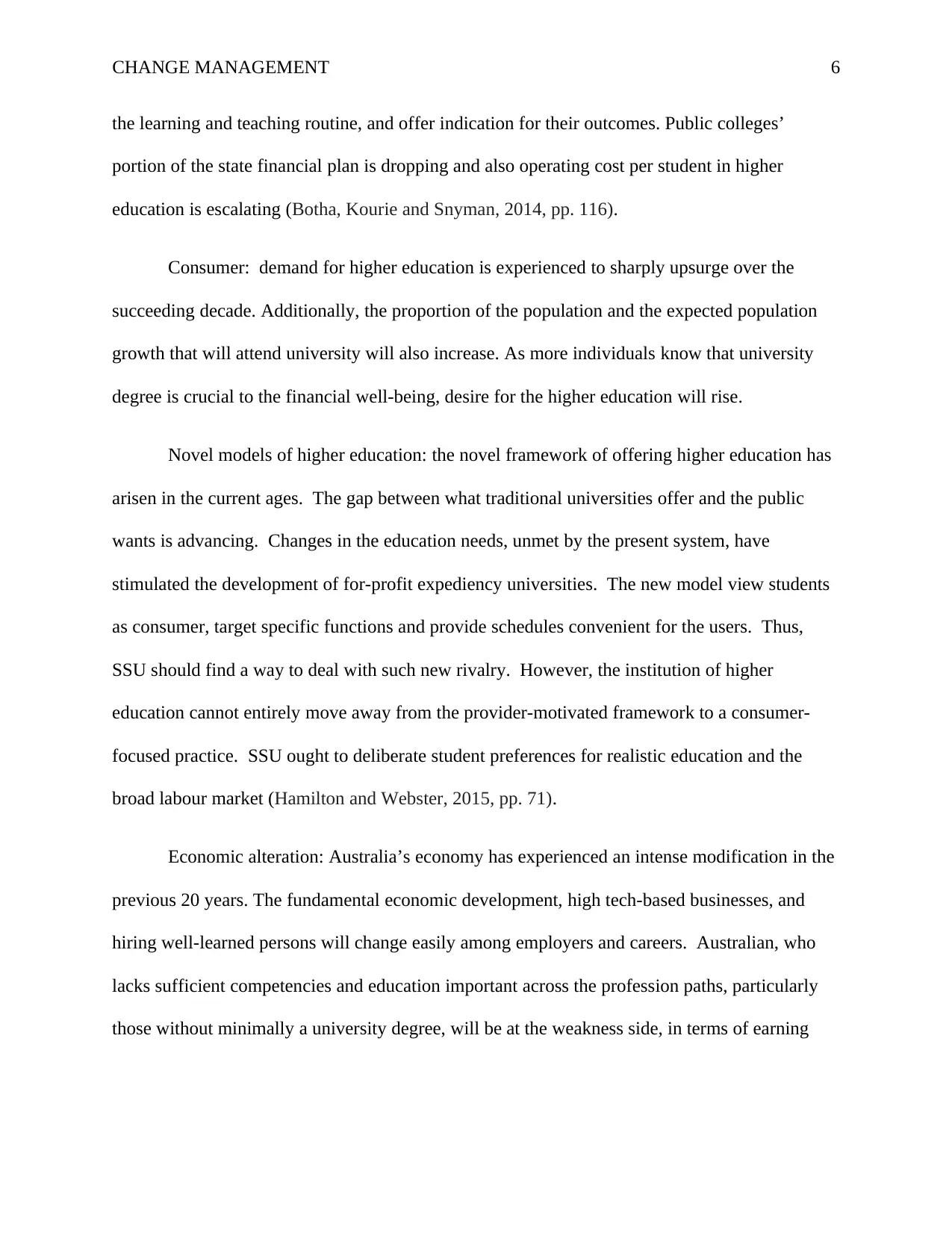
CHANGE MANAGEMENT 6
the learning and teaching routine, and offer indication for their outcomes. Public colleges’
portion of the state financial plan is dropping and also operating cost per student in higher
education is escalating (Botha, Kourie and Snyman, 2014, pp. 116).
Consumer: demand for higher education is experienced to sharply upsurge over the
succeeding decade. Additionally, the proportion of the population and the expected population
growth that will attend university will also increase. As more individuals know that university
degree is crucial to the financial well-being, desire for the higher education will rise.
Novel models of higher education: the novel framework of offering higher education has
arisen in the current ages. The gap between what traditional universities offer and the public
wants is advancing. Changes in the education needs, unmet by the present system, have
stimulated the development of for-profit expediency universities. The new model view students
as consumer, target specific functions and provide schedules convenient for the users. Thus,
SSU should find a way to deal with such new rivalry. However, the institution of higher
education cannot entirely move away from the provider-motivated framework to a consumer-
focused practice. SSU ought to deliberate student preferences for realistic education and the
broad labour market (Hamilton and Webster, 2015, pp. 71).
Economic alteration: Australia’s economy has experienced an intense modification in the
previous 20 years. The fundamental economic development, high tech-based businesses, and
hiring well-learned persons will change easily among employers and careers. Australian, who
lacks sufficient competencies and education important across the profession paths, particularly
those without minimally a university degree, will be at the weakness side, in terms of earning
the learning and teaching routine, and offer indication for their outcomes. Public colleges’
portion of the state financial plan is dropping and also operating cost per student in higher
education is escalating (Botha, Kourie and Snyman, 2014, pp. 116).
Consumer: demand for higher education is experienced to sharply upsurge over the
succeeding decade. Additionally, the proportion of the population and the expected population
growth that will attend university will also increase. As more individuals know that university
degree is crucial to the financial well-being, desire for the higher education will rise.
Novel models of higher education: the novel framework of offering higher education has
arisen in the current ages. The gap between what traditional universities offer and the public
wants is advancing. Changes in the education needs, unmet by the present system, have
stimulated the development of for-profit expediency universities. The new model view students
as consumer, target specific functions and provide schedules convenient for the users. Thus,
SSU should find a way to deal with such new rivalry. However, the institution of higher
education cannot entirely move away from the provider-motivated framework to a consumer-
focused practice. SSU ought to deliberate student preferences for realistic education and the
broad labour market (Hamilton and Webster, 2015, pp. 71).
Economic alteration: Australia’s economy has experienced an intense modification in the
previous 20 years. The fundamental economic development, high tech-based businesses, and
hiring well-learned persons will change easily among employers and careers. Australian, who
lacks sufficient competencies and education important across the profession paths, particularly
those without minimally a university degree, will be at the weakness side, in terms of earning
⊘ This is a preview!⊘
Do you want full access?
Subscribe today to unlock all pages.

Trusted by 1+ million students worldwide
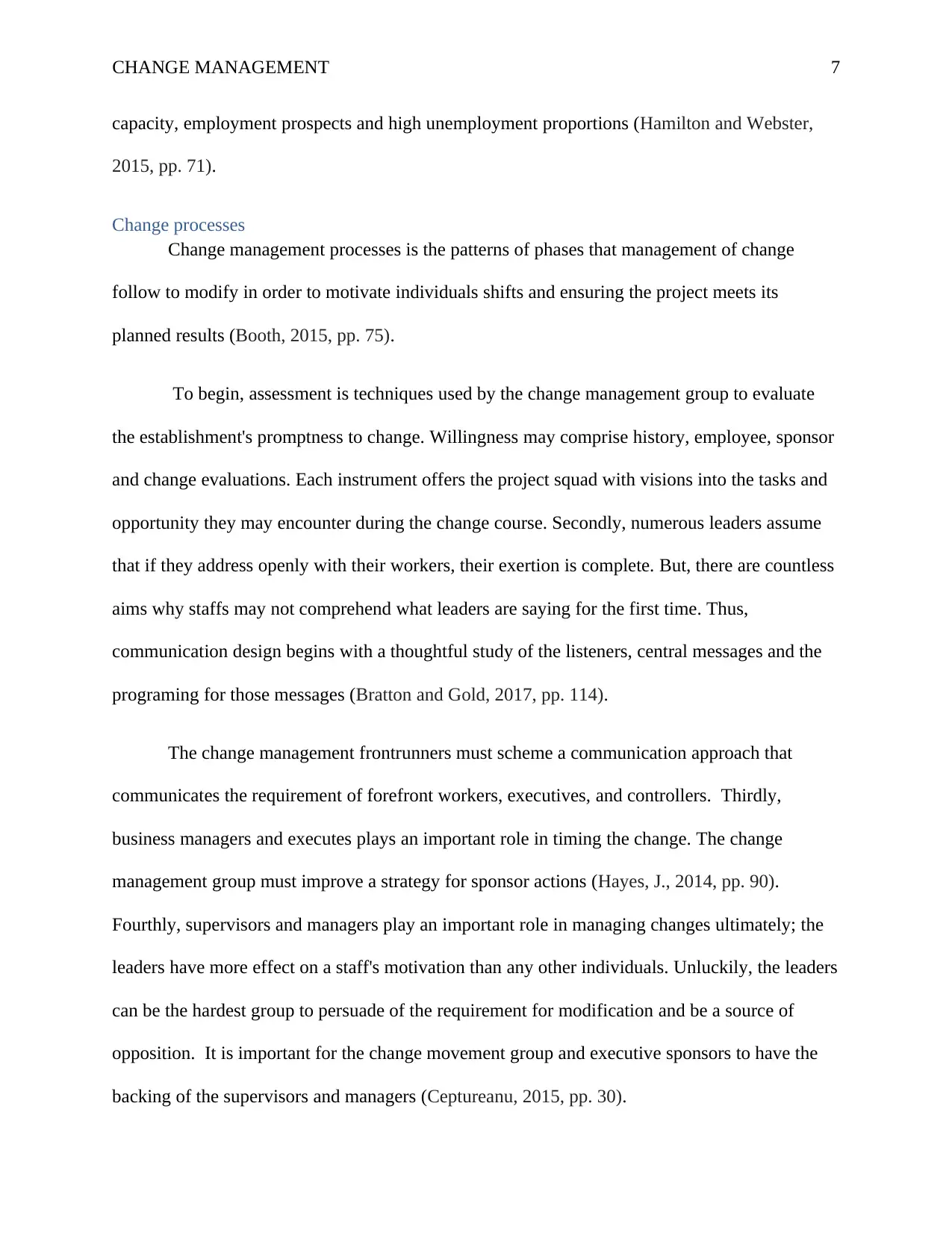
CHANGE MANAGEMENT 7
capacity, employment prospects and high unemployment proportions (Hamilton and Webster,
2015, pp. 71).
Change processes
Change management processes is the patterns of phases that management of change
follow to modify in order to motivate individuals shifts and ensuring the project meets its
planned results (Booth, 2015, pp. 75).
To begin, assessment is techniques used by the change management group to evaluate
the establishment's promptness to change. Willingness may comprise history, employee, sponsor
and change evaluations. Each instrument offers the project squad with visions into the tasks and
opportunity they may encounter during the change course. Secondly, numerous leaders assume
that if they address openly with their workers, their exertion is complete. But, there are countless
aims why staffs may not comprehend what leaders are saying for the first time. Thus,
communication design begins with a thoughtful study of the listeners, central messages and the
programing for those messages (Bratton and Gold, 2017, pp. 114).
The change management frontrunners must scheme a communication approach that
communicates the requirement of forefront workers, executives, and controllers. Thirdly,
business managers and executes plays an important role in timing the change. The change
management group must improve a strategy for sponsor actions (Hayes, J., 2014, pp. 90).
Fourthly, supervisors and managers play an important role in managing changes ultimately; the
leaders have more effect on a staff's motivation than any other individuals. Unluckily, the leaders
can be the hardest group to persuade of the requirement for modification and be a source of
opposition. It is important for the change movement group and executive sponsors to have the
backing of the supervisors and managers (Ceptureanu, 2015, pp. 30).
capacity, employment prospects and high unemployment proportions (Hamilton and Webster,
2015, pp. 71).
Change processes
Change management processes is the patterns of phases that management of change
follow to modify in order to motivate individuals shifts and ensuring the project meets its
planned results (Booth, 2015, pp. 75).
To begin, assessment is techniques used by the change management group to evaluate
the establishment's promptness to change. Willingness may comprise history, employee, sponsor
and change evaluations. Each instrument offers the project squad with visions into the tasks and
opportunity they may encounter during the change course. Secondly, numerous leaders assume
that if they address openly with their workers, their exertion is complete. But, there are countless
aims why staffs may not comprehend what leaders are saying for the first time. Thus,
communication design begins with a thoughtful study of the listeners, central messages and the
programing for those messages (Bratton and Gold, 2017, pp. 114).
The change management frontrunners must scheme a communication approach that
communicates the requirement of forefront workers, executives, and controllers. Thirdly,
business managers and executes plays an important role in timing the change. The change
management group must improve a strategy for sponsor actions (Hayes, J., 2014, pp. 90).
Fourthly, supervisors and managers play an important role in managing changes ultimately; the
leaders have more effect on a staff's motivation than any other individuals. Unluckily, the leaders
can be the hardest group to persuade of the requirement for modification and be a source of
opposition. It is important for the change movement group and executive sponsors to have the
backing of the supervisors and managers (Ceptureanu, 2015, pp. 30).
Paraphrase This Document
Need a fresh take? Get an instant paraphrase of this document with our AI Paraphraser
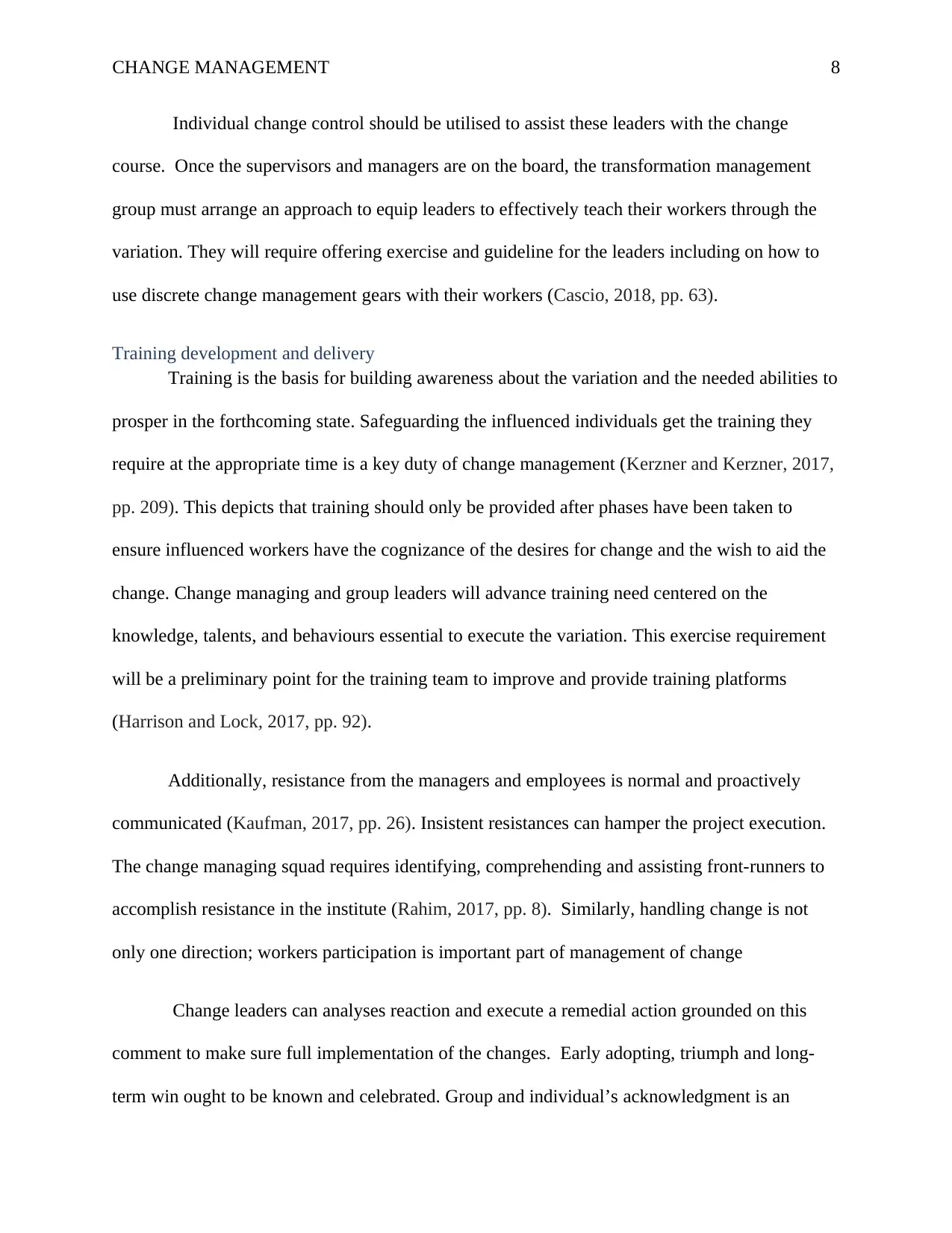
CHANGE MANAGEMENT 8
Individual change control should be utilised to assist these leaders with the change
course. Once the supervisors and managers are on the board, the transformation management
group must arrange an approach to equip leaders to effectively teach their workers through the
variation. They will require offering exercise and guideline for the leaders including on how to
use discrete change management gears with their workers (Cascio, 2018, pp. 63).
Training development and delivery
Training is the basis for building awareness about the variation and the needed abilities to
prosper in the forthcoming state. Safeguarding the influenced individuals get the training they
require at the appropriate time is a key duty of change management (Kerzner and Kerzner, 2017,
pp. 209). This depicts that training should only be provided after phases have been taken to
ensure influenced workers have the cognizance of the desires for change and the wish to aid the
change. Change managing and group leaders will advance training need centered on the
knowledge, talents, and behaviours essential to execute the variation. This exercise requirement
will be a preliminary point for the training team to improve and provide training platforms
(Harrison and Lock, 2017, pp. 92).
Additionally, resistance from the managers and employees is normal and proactively
communicated (Kaufman, 2017, pp. 26). Insistent resistances can hamper the project execution.
The change managing squad requires identifying, comprehending and assisting front-runners to
accomplish resistance in the institute (Rahim, 2017, pp. 8). Similarly, handling change is not
only one direction; workers participation is important part of management of change
Change leaders can analyses reaction and execute a remedial action grounded on this
comment to make sure full implementation of the changes. Early adopting, triumph and long-
term win ought to be known and celebrated. Group and individual’s acknowledgment is an
Individual change control should be utilised to assist these leaders with the change
course. Once the supervisors and managers are on the board, the transformation management
group must arrange an approach to equip leaders to effectively teach their workers through the
variation. They will require offering exercise and guideline for the leaders including on how to
use discrete change management gears with their workers (Cascio, 2018, pp. 63).
Training development and delivery
Training is the basis for building awareness about the variation and the needed abilities to
prosper in the forthcoming state. Safeguarding the influenced individuals get the training they
require at the appropriate time is a key duty of change management (Kerzner and Kerzner, 2017,
pp. 209). This depicts that training should only be provided after phases have been taken to
ensure influenced workers have the cognizance of the desires for change and the wish to aid the
change. Change managing and group leaders will advance training need centered on the
knowledge, talents, and behaviours essential to execute the variation. This exercise requirement
will be a preliminary point for the training team to improve and provide training platforms
(Harrison and Lock, 2017, pp. 92).
Additionally, resistance from the managers and employees is normal and proactively
communicated (Kaufman, 2017, pp. 26). Insistent resistances can hamper the project execution.
The change managing squad requires identifying, comprehending and assisting front-runners to
accomplish resistance in the institute (Rahim, 2017, pp. 8). Similarly, handling change is not
only one direction; workers participation is important part of management of change
Change leaders can analyses reaction and execute a remedial action grounded on this
comment to make sure full implementation of the changes. Early adopting, triumph and long-
term win ought to be known and celebrated. Group and individual’s acknowledgment is an
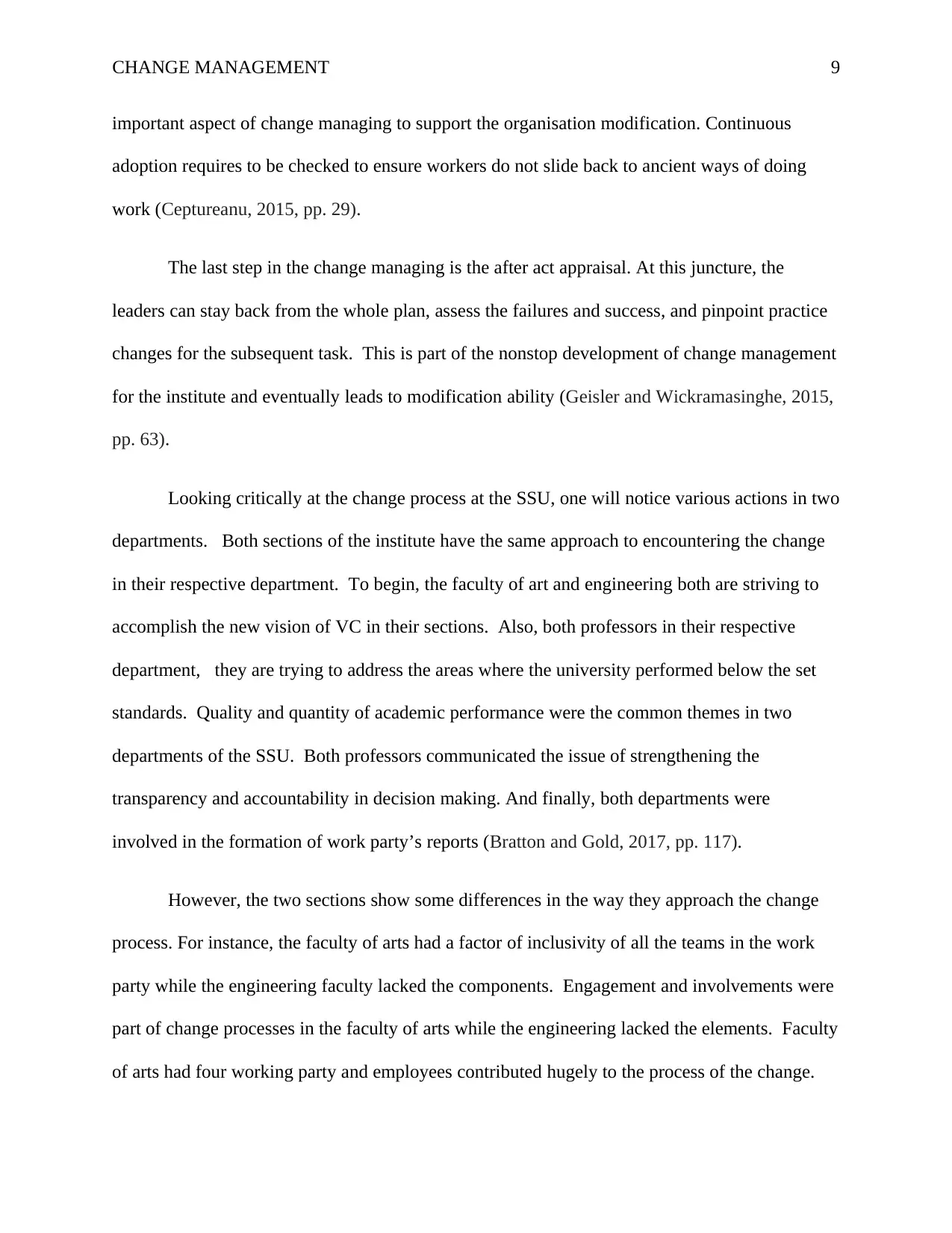
CHANGE MANAGEMENT 9
important aspect of change managing to support the organisation modification. Continuous
adoption requires to be checked to ensure workers do not slide back to ancient ways of doing
work (Ceptureanu, 2015, pp. 29).
The last step in the change managing is the after act appraisal. At this juncture, the
leaders can stay back from the whole plan, assess the failures and success, and pinpoint practice
changes for the subsequent task. This is part of the nonstop development of change management
for the institute and eventually leads to modification ability (Geisler and Wickramasinghe, 2015,
pp. 63).
Looking critically at the change process at the SSU, one will notice various actions in two
departments. Both sections of the institute have the same approach to encountering the change
in their respective department. To begin, the faculty of art and engineering both are striving to
accomplish the new vision of VC in their sections. Also, both professors in their respective
department, they are trying to address the areas where the university performed below the set
standards. Quality and quantity of academic performance were the common themes in two
departments of the SSU. Both professors communicated the issue of strengthening the
transparency and accountability in decision making. And finally, both departments were
involved in the formation of work party’s reports (Bratton and Gold, 2017, pp. 117).
However, the two sections show some differences in the way they approach the change
process. For instance, the faculty of arts had a factor of inclusivity of all the teams in the work
party while the engineering faculty lacked the components. Engagement and involvements were
part of change processes in the faculty of arts while the engineering lacked the elements. Faculty
of arts had four working party and employees contributed hugely to the process of the change.
important aspect of change managing to support the organisation modification. Continuous
adoption requires to be checked to ensure workers do not slide back to ancient ways of doing
work (Ceptureanu, 2015, pp. 29).
The last step in the change managing is the after act appraisal. At this juncture, the
leaders can stay back from the whole plan, assess the failures and success, and pinpoint practice
changes for the subsequent task. This is part of the nonstop development of change management
for the institute and eventually leads to modification ability (Geisler and Wickramasinghe, 2015,
pp. 63).
Looking critically at the change process at the SSU, one will notice various actions in two
departments. Both sections of the institute have the same approach to encountering the change
in their respective department. To begin, the faculty of art and engineering both are striving to
accomplish the new vision of VC in their sections. Also, both professors in their respective
department, they are trying to address the areas where the university performed below the set
standards. Quality and quantity of academic performance were the common themes in two
departments of the SSU. Both professors communicated the issue of strengthening the
transparency and accountability in decision making. And finally, both departments were
involved in the formation of work party’s reports (Bratton and Gold, 2017, pp. 117).
However, the two sections show some differences in the way they approach the change
process. For instance, the faculty of arts had a factor of inclusivity of all the teams in the work
party while the engineering faculty lacked the components. Engagement and involvements were
part of change processes in the faculty of arts while the engineering lacked the elements. Faculty
of arts had four working party and employees contributed hugely to the process of the change.
⊘ This is a preview!⊘
Do you want full access?
Subscribe today to unlock all pages.

Trusted by 1+ million students worldwide
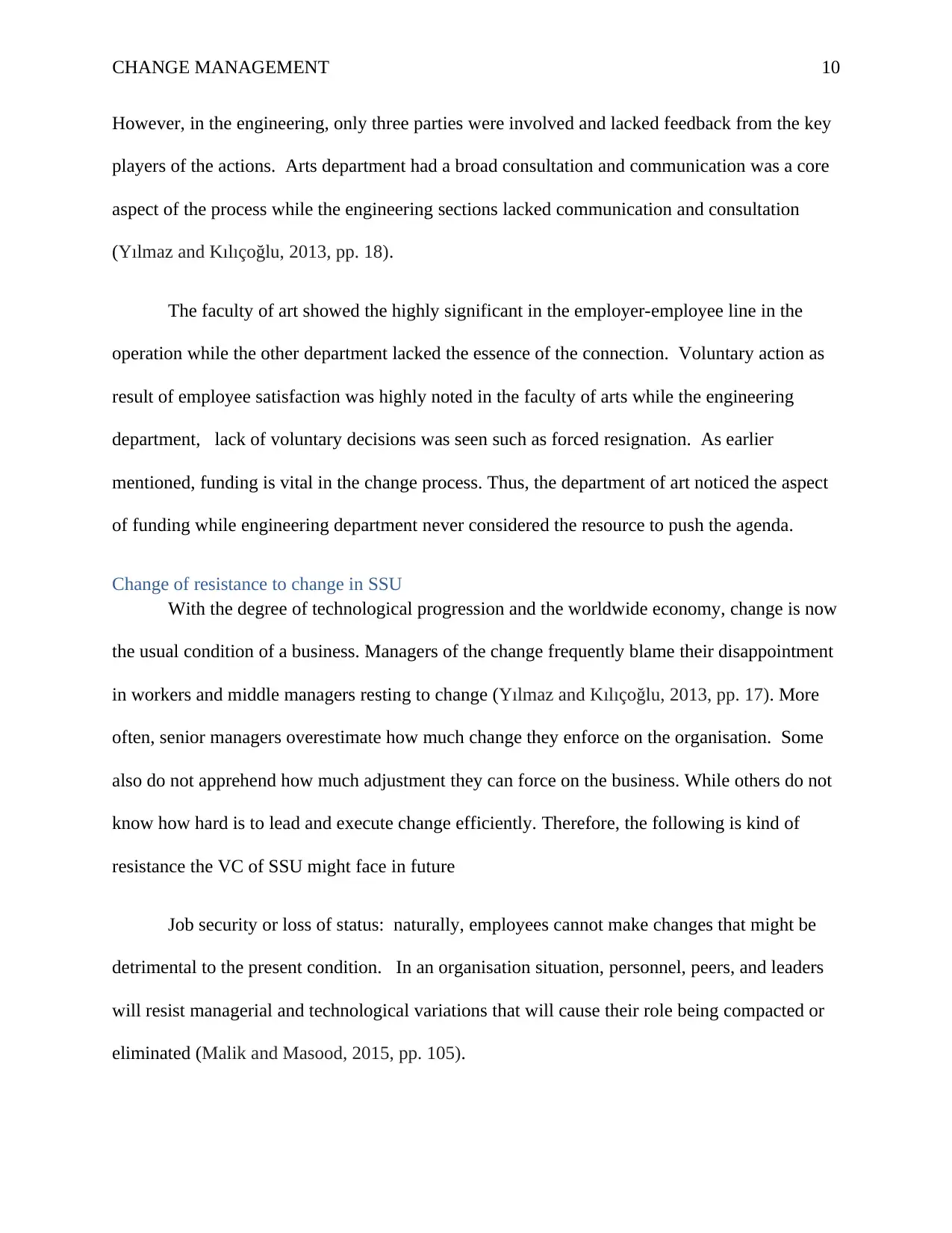
CHANGE MANAGEMENT 10
However, in the engineering, only three parties were involved and lacked feedback from the key
players of the actions. Arts department had a broad consultation and communication was a core
aspect of the process while the engineering sections lacked communication and consultation
(Yılmaz and Kılıçoğlu, 2013, pp. 18).
The faculty of art showed the highly significant in the employer-employee line in the
operation while the other department lacked the essence of the connection. Voluntary action as
result of employee satisfaction was highly noted in the faculty of arts while the engineering
department, lack of voluntary decisions was seen such as forced resignation. As earlier
mentioned, funding is vital in the change process. Thus, the department of art noticed the aspect
of funding while engineering department never considered the resource to push the agenda.
Change of resistance to change in SSU
With the degree of technological progression and the worldwide economy, change is now
the usual condition of a business. Managers of the change frequently blame their disappointment
in workers and middle managers resting to change (Yılmaz and Kılıçoğlu, 2013, pp. 17). More
often, senior managers overestimate how much change they enforce on the organisation. Some
also do not apprehend how much adjustment they can force on the business. While others do not
know how hard is to lead and execute change efficiently. Therefore, the following is kind of
resistance the VC of SSU might face in future
Job security or loss of status: naturally, employees cannot make changes that might be
detrimental to the present condition. In an organisation situation, personnel, peers, and leaders
will resist managerial and technological variations that will cause their role being compacted or
eliminated (Malik and Masood, 2015, pp. 105).
However, in the engineering, only three parties were involved and lacked feedback from the key
players of the actions. Arts department had a broad consultation and communication was a core
aspect of the process while the engineering sections lacked communication and consultation
(Yılmaz and Kılıçoğlu, 2013, pp. 18).
The faculty of art showed the highly significant in the employer-employee line in the
operation while the other department lacked the essence of the connection. Voluntary action as
result of employee satisfaction was highly noted in the faculty of arts while the engineering
department, lack of voluntary decisions was seen such as forced resignation. As earlier
mentioned, funding is vital in the change process. Thus, the department of art noticed the aspect
of funding while engineering department never considered the resource to push the agenda.
Change of resistance to change in SSU
With the degree of technological progression and the worldwide economy, change is now
the usual condition of a business. Managers of the change frequently blame their disappointment
in workers and middle managers resting to change (Yılmaz and Kılıçoğlu, 2013, pp. 17). More
often, senior managers overestimate how much change they enforce on the organisation. Some
also do not apprehend how much adjustment they can force on the business. While others do not
know how hard is to lead and execute change efficiently. Therefore, the following is kind of
resistance the VC of SSU might face in future
Job security or loss of status: naturally, employees cannot make changes that might be
detrimental to the present condition. In an organisation situation, personnel, peers, and leaders
will resist managerial and technological variations that will cause their role being compacted or
eliminated (Malik and Masood, 2015, pp. 105).
Paraphrase This Document
Need a fresh take? Get an instant paraphrase of this document with our AI Paraphraser
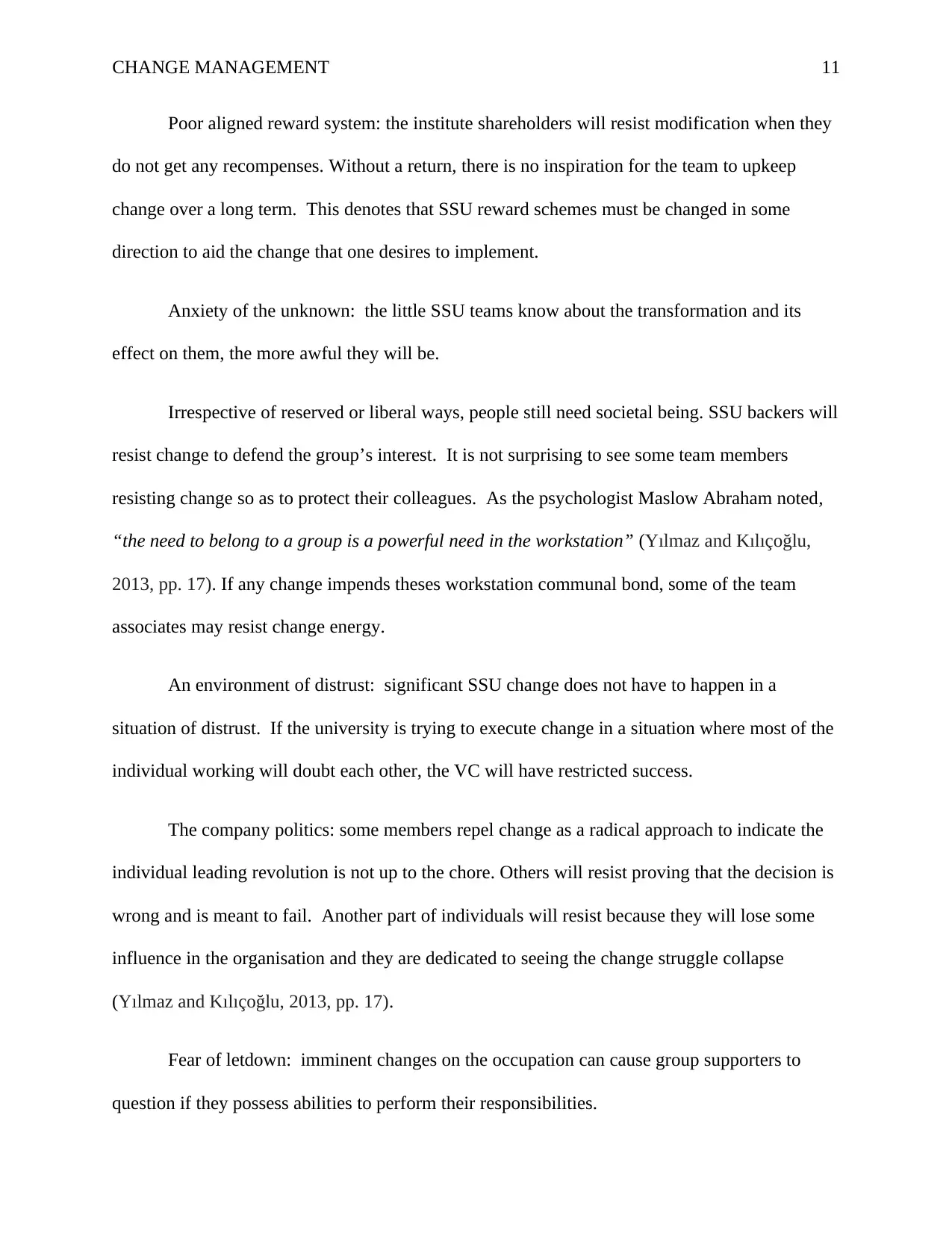
CHANGE MANAGEMENT 11
Poor aligned reward system: the institute shareholders will resist modification when they
do not get any recompenses. Without a return, there is no inspiration for the team to upkeep
change over a long term. This denotes that SSU reward schemes must be changed in some
direction to aid the change that one desires to implement.
Anxiety of the unknown: the little SSU teams know about the transformation and its
effect on them, the more awful they will be.
Irrespective of reserved or liberal ways, people still need societal being. SSU backers will
resist change to defend the group’s interest. It is not surprising to see some team members
resisting change so as to protect their colleagues. As the psychologist Maslow Abraham noted,
“the need to belong to a group is a powerful need in the workstation” (Yılmaz and Kılıçoğlu,
2013, pp. 17). If any change impends theses workstation communal bond, some of the team
associates may resist change energy.
An environment of distrust: significant SSU change does not have to happen in a
situation of distrust. If the university is trying to execute change in a situation where most of the
individual working will doubt each other, the VC will have restricted success.
The company politics: some members repel change as a radical approach to indicate the
individual leading revolution is not up to the chore. Others will resist proving that the decision is
wrong and is meant to fail. Another part of individuals will resist because they will lose some
influence in the organisation and they are dedicated to seeing the change struggle collapse
(Yılmaz and Kılıçoğlu, 2013, pp. 17).
Fear of letdown: imminent changes on the occupation can cause group supporters to
question if they possess abilities to perform their responsibilities.
Poor aligned reward system: the institute shareholders will resist modification when they
do not get any recompenses. Without a return, there is no inspiration for the team to upkeep
change over a long term. This denotes that SSU reward schemes must be changed in some
direction to aid the change that one desires to implement.
Anxiety of the unknown: the little SSU teams know about the transformation and its
effect on them, the more awful they will be.
Irrespective of reserved or liberal ways, people still need societal being. SSU backers will
resist change to defend the group’s interest. It is not surprising to see some team members
resisting change so as to protect their colleagues. As the psychologist Maslow Abraham noted,
“the need to belong to a group is a powerful need in the workstation” (Yılmaz and Kılıçoğlu,
2013, pp. 17). If any change impends theses workstation communal bond, some of the team
associates may resist change energy.
An environment of distrust: significant SSU change does not have to happen in a
situation of distrust. If the university is trying to execute change in a situation where most of the
individual working will doubt each other, the VC will have restricted success.
The company politics: some members repel change as a radical approach to indicate the
individual leading revolution is not up to the chore. Others will resist proving that the decision is
wrong and is meant to fail. Another part of individuals will resist because they will lose some
influence in the organisation and they are dedicated to seeing the change struggle collapse
(Yılmaz and Kılıçoğlu, 2013, pp. 17).
Fear of letdown: imminent changes on the occupation can cause group supporters to
question if they possess abilities to perform their responsibilities.
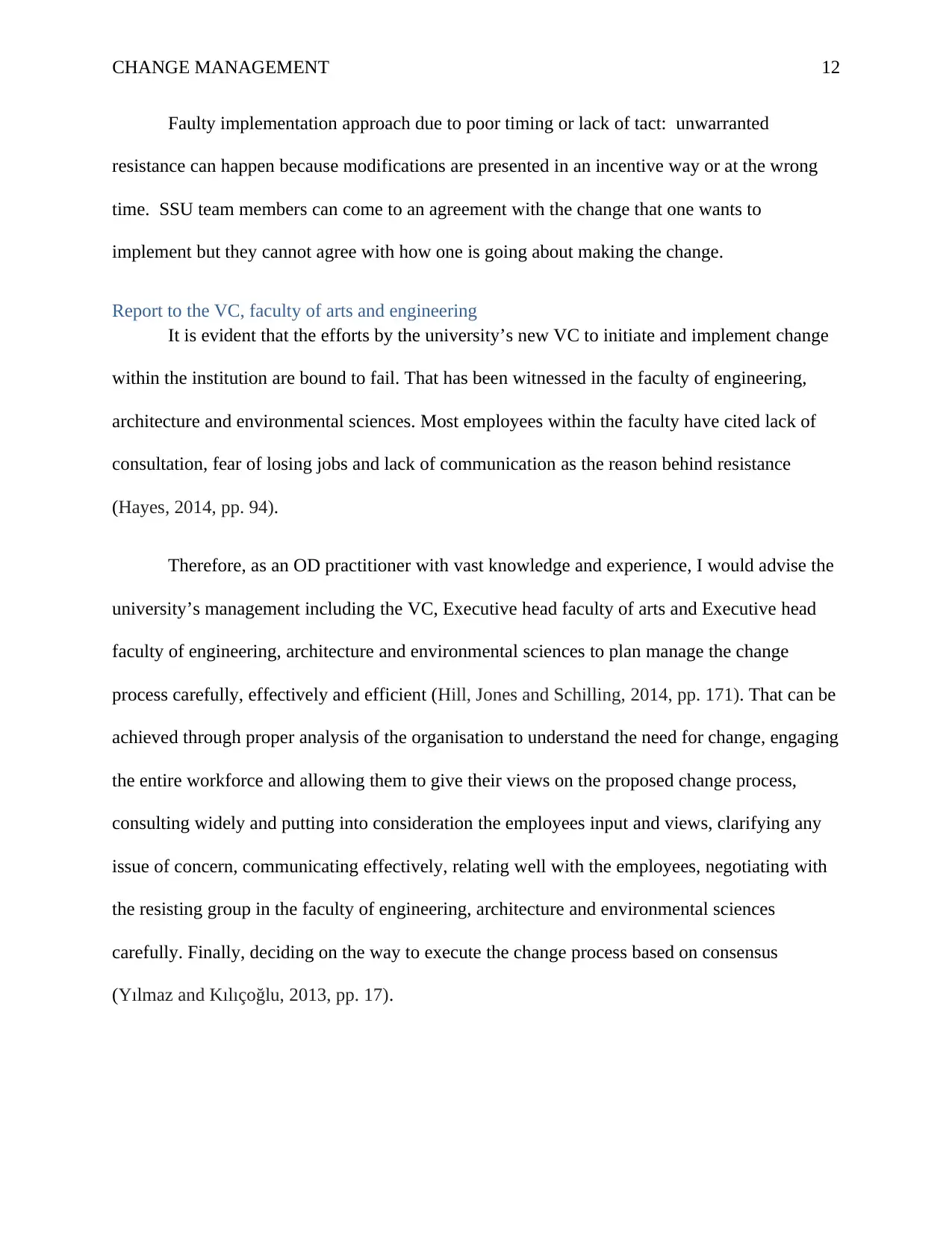
CHANGE MANAGEMENT 12
Faulty implementation approach due to poor timing or lack of tact: unwarranted
resistance can happen because modifications are presented in an incentive way or at the wrong
time. SSU team members can come to an agreement with the change that one wants to
implement but they cannot agree with how one is going about making the change.
Report to the VC, faculty of arts and engineering
It is evident that the efforts by the university’s new VC to initiate and implement change
within the institution are bound to fail. That has been witnessed in the faculty of engineering,
architecture and environmental sciences. Most employees within the faculty have cited lack of
consultation, fear of losing jobs and lack of communication as the reason behind resistance
(Hayes, 2014, pp. 94).
Therefore, as an OD practitioner with vast knowledge and experience, I would advise the
university’s management including the VC, Executive head faculty of arts and Executive head
faculty of engineering, architecture and environmental sciences to plan manage the change
process carefully, effectively and efficient (Hill, Jones and Schilling, 2014, pp. 171). That can be
achieved through proper analysis of the organisation to understand the need for change, engaging
the entire workforce and allowing them to give their views on the proposed change process,
consulting widely and putting into consideration the employees input and views, clarifying any
issue of concern, communicating effectively, relating well with the employees, negotiating with
the resisting group in the faculty of engineering, architecture and environmental sciences
carefully. Finally, deciding on the way to execute the change process based on consensus
(Yılmaz and Kılıçoğlu, 2013, pp. 17).
Faulty implementation approach due to poor timing or lack of tact: unwarranted
resistance can happen because modifications are presented in an incentive way or at the wrong
time. SSU team members can come to an agreement with the change that one wants to
implement but they cannot agree with how one is going about making the change.
Report to the VC, faculty of arts and engineering
It is evident that the efforts by the university’s new VC to initiate and implement change
within the institution are bound to fail. That has been witnessed in the faculty of engineering,
architecture and environmental sciences. Most employees within the faculty have cited lack of
consultation, fear of losing jobs and lack of communication as the reason behind resistance
(Hayes, 2014, pp. 94).
Therefore, as an OD practitioner with vast knowledge and experience, I would advise the
university’s management including the VC, Executive head faculty of arts and Executive head
faculty of engineering, architecture and environmental sciences to plan manage the change
process carefully, effectively and efficient (Hill, Jones and Schilling, 2014, pp. 171). That can be
achieved through proper analysis of the organisation to understand the need for change, engaging
the entire workforce and allowing them to give their views on the proposed change process,
consulting widely and putting into consideration the employees input and views, clarifying any
issue of concern, communicating effectively, relating well with the employees, negotiating with
the resisting group in the faculty of engineering, architecture and environmental sciences
carefully. Finally, deciding on the way to execute the change process based on consensus
(Yılmaz and Kılıçoğlu, 2013, pp. 17).
⊘ This is a preview!⊘
Do you want full access?
Subscribe today to unlock all pages.

Trusted by 1+ million students worldwide
1 out of 15
Related Documents
Your All-in-One AI-Powered Toolkit for Academic Success.
+13062052269
info@desklib.com
Available 24*7 on WhatsApp / Email
![[object Object]](/_next/static/media/star-bottom.7253800d.svg)
Unlock your academic potential
Copyright © 2020–2025 A2Z Services. All Rights Reserved. Developed and managed by ZUCOL.




